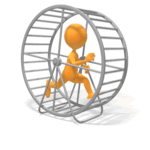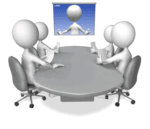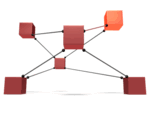 The expected response to any suggestion of change is “Yes, but I am too busy – I do not have time.”
The expected response to any suggestion of change is “Yes, but I am too busy – I do not have time.”
And the respondent is correct. They do not.
All their time is used just keeping their head above water or spinning the hamster wheel or whatever other metaphor they feel is appropriate. We are at an impasse. A stalemate. We know change requires some investment of time and there is no spare time to invest so change cannot happen. Yes? But that is not good enough – is it?
Well-intended experts proclaim that “I’m too busy” actually means “I have other things to do that are higher priority“. And by that we mean ” … that are a greater threat to my security and to what I care about“. So to get our engagement our well-intended expert pours emotional petrol on us and sets light to it. They show us dramatic video evidence of how our “can’t do” attitude and behaviour is part of the problem. We are the recalcitrant child who is standing in the way of change and we need to have our face rubbed in our own cynical poo.
Now our platform is really burning. Inflamed is exactly what we are feeling – angry in fact. “Thanks-a-lot. Now #!*@ off!” And our well-intentioned expert retreats – it is always the same. The Dinosaurs and the Dead Wood are clogging the way ahead.
Perhaps a different perspective might be more constructive.
It is not just how much time we have that is most important – it is how our time is structured.
Humans hate unstructured time. We like to be mentally active for all of our waking moments.
To test this hypothesis try this demonstration of our human need to fill idle time with activity. When you next talk to someone you know well – at some point after they have finished telling you something just say nothing; keep looking at them; and keep listening – and say nothing. For up to twenty seconds if necessary. Both you and they will feel an overwhelming urge to say something, anything – to fill the silence. It is called the “pregnant pause effect” and most people find even a gap of a second or two feels uncomfortable. Ten seconds would be almost unbearable. Hold your nerve and stay quiet. They will fill the gap.
This technique is used by cognitive behavioural therapists, counsellors and coaches to help us reveal stuff about ourselves to ourselves – and it works incredibly well. It is also used for less altrusitic purposes by some – so when you feel the pain of the pregnant pause just be aware of what might be going on and counter with a question.
If we have no imposed structure for our time then we will create one – because we feel better for it. We have a name for these time-structuring behaviours: habits, past-times and rituals. And they are very important to us because they reduce anxiety.
 There is another name for a pre-meditated time-structure: it is called a plan or a process design. Many people hate not having a plan – and to them any plan is better than none. So in the absence of an imposed alternative we habitually make do with time-wasting plans and poorly designed processes. We feel busy because that is the purpose of our time-structuring behaviour – and we look busy too – which is also important. This has an important lesson for all improvement scientists: Using a measure of “business” such as utilisation as a measure of efficiency and productivity is almost meaningless. Utilisation does not distinguish between useful busi-ness and useless busi-ness.
There is another name for a pre-meditated time-structure: it is called a plan or a process design. Many people hate not having a plan – and to them any plan is better than none. So in the absence of an imposed alternative we habitually make do with time-wasting plans and poorly designed processes. We feel busy because that is the purpose of our time-structuring behaviour – and we look busy too – which is also important. This has an important lesson for all improvement scientists: Using a measure of “business” such as utilisation as a measure of efficiency and productivity is almost meaningless. Utilisation does not distinguish between useful busi-ness and useless busi-ness.
We also time-structure our non-working lives. Reading a newspaper, doing the crossword, listening to the radio, watching television, and web-browsing are all time-structuring behaviours.
This insight into our need for structured time leads to a rational way to release time for change and improvement – and that is to better structure some of our busy time.
A useful metaphor for a time-structure is a tangible structure – such as a building. Buildings have two parts – a supporting, load bearing, structural framework and the functional fittings that are attached to it. Often the structural framework is invisible in the final building – invisible but essential. That is why we need structural engineers. The same is true for time-structuring: the supporting form should be there but it should not not get in the way of the intended function. That is why we need process design engineers too. Good process design is invisible time-structuring.
One essential investment of time in all organisations is communication. Face-to-face talking, phone calls, SMS, emails, reports, meetings, presentations, webex and so on. We spend more time communicating with each other than doing anything else other than sleeping. And more niggles are generated by poorly designed and delivered communication processes than everything else combined. By a long way.
 As an example let us consider management meetings.
As an example let us consider management meetings.
From a process design perspective mmany management meetings are both ineffective and inefficient. They are unproductive. So why do we still have them?
One possibkle answer is because meetings have two other important purposes: first as a tool for social interaction, and second as a way to structure time. It turns out that we dislike loneliness even more than idleness – and we can meet both needs at the same time by having a meeting. Productivity is not the primary purpose.
So when we do have to communicate effectively and efficiently in order to collectively resolve a real and urgent problem then we are ill prepared. And we know this. We know that as soon as Crisis Management Committees start to form then we are in really big trouble. What we want in a time of crisis is for someone to structure time for us. To tell us what to do.
And some believe that we unconsciously create crisis after crisis for just that purpose.
Recently I have been running an improvement experiment. I have been testing the assumption that we have to meet face-to-face to be effective. This has big implications for efficiency because I work in a multi-site organisation and to attend a meeting on another site implies travelling there and back. That travel takes one hour in each direction when all the separate parts are added together. It has two other costs. The financial cost of the fuel – which is a variable cost – if I do not travel then I do not incur the cost. And there is an emotional cost – I have to concentrate on driving and will use up some of my brain-fuel in doing so. There are three currencies – emotional, temporal and financial.
The experiment was a design change. I changed the design of the communication process from at-the-same-place-and-time to just at-the-same-time. I used an internet-based computer-to-computer link (rather like Skype or FaceTime but with some other useful tools like application sharing).
 It worked much better than I expected.
It worked much better than I expected.
There was the anticipated “we cannot do this because we do not have webcams and no budget for even pencils“. This was solved by buying webcams from the money saved by not burning petrol. The conversion rate was one webcam per four trips – and the webcam is a one off capital cost not a recurring revenue cost. This is accpiuntant-speak for “the actual cash released will fund the change“. No extra budget is required. And combine the fuel savings for everyone, and parking charges and the payback time is even shorter.
There were also the anticipated glitches as people got used to the unfamiliar technology (they did not practice of course because they were too busy) but the niggles go away with a few iterations.
So what were the other benefits?
 Well one was the travel time saved – two hours per meeting – which was longer than the meeting! The released time cannot be stored and used later like the money can – it has to be reinvested immediately. I reinvested it in other improvement work. So the benefit was amplified.
Well one was the travel time saved – two hours per meeting – which was longer than the meeting! The released time cannot be stored and used later like the money can – it has to be reinvested immediately. I reinvested it in other improvement work. So the benefit was amplified.
Another was the brain-fuel saved from not having to drive – which I used to offset my cumuative brain-fuel deficit called chronic fatigue. The left over was re-invested in the improvement work. 100% recycled. Nothing was wasted.
 The unexpected benefit was the biggest one.
The unexpected benefit was the biggest one.
The different communication design of a virtual meeting required a different form of meeting structure and discipline. It took a few iterations to realise this – then click – both effectiveness and efficiency jumped up. The time became even better structured, more productive and released even more time to reinvest. Wow!
And the whole thing funded itself.
